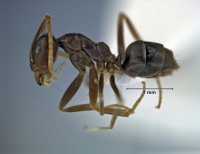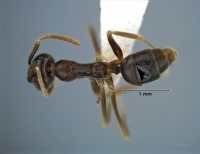Leptomyrmex ramorniensis
| Leptomyrmex ramorniensis | |
|---|---|

| |
| Leptomyrmex ramorniensis | |
| Scientific classification | |
| Kingdom: | Animalia |
| Phylum: | Arthropoda |
| Class: | Insecta |
| Order: | Hymenoptera |
| Family: | Formicidae |
| Subfamily: | Dolichoderinae |
| Tribe: | Leptomyrmecini |
| Genus: | Leptomyrmex |
| Species: | L. ramorniensis |
| Binomial name | |
| Leptomyrmex ramorniensis Smith, D.J. & Shattuck, 2009 | |
Leptomyrmex ramorniensis is known only from Ramornie State Forest, near Grafton, northeastern New South Wales. Given the extensive trapping program undertaken in this region by NEFBS (Grey & Cassis, 1994) and the wide distribution found for the closely related Leptomyrmex aitchisoni, it seems likely that this single forest represents the total range of the species. (Smith and Shattuck 2009)
Identification
Head relatively short (CI greater than 80); antennae relatively short (SI less than 150) and extending beyond the vertex of the head by less than half their length; palps short, not reaching the posterior of the head; hind tibial spurs with barbules longer than the width of the shaft. This species is morphologically distinct from all other micro-Leptomyrmex species and is in some ways the least typical Leptomyrmex species so far known. It differs in having a shorter and wider head and relatively short antennae, palps and legs. (Smith and Shattuck 2009)
Identification Keys including this Taxon
Distribution
Latitudinal Distribution Pattern
Latitudinal Range: -29.69694° to -29.72304°.
| North Temperate |
North Subtropical |
Tropical | South Subtropical |
South Temperate |
- Source: AntMaps
Distribution based on Regional Taxon Lists
Australasian Region: Australia (type locality).
Distribution based on AntMaps
Distribution based on AntWeb specimens
Check data from AntWeb
Countries Occupied
| Number of countries occupied by this species based on AntWiki Regional Taxon Lists. In general, fewer countries occupied indicates a narrower range, while more countries indicates a more widespread species. |

|
Estimated Abundance
| Relative abundance based on number of AntMaps records per species (this species within the purple bar). Fewer records (to the left) indicates a less abundant/encountered species while more records (to the right) indicates more abundant/encountered species. |

|
Biology
Castes
Nomenclature
The following information is derived from Barry Bolton's Online Catalogue of the Ants of the World.
- ramorniensis. Leptomyrmex ramorniensis Smith, D.J. & Shattuck, 2009: 66, figs. 16-18, 19, 21, 24 (w.) AUSTRALIA.
Type Material
- Holotype, worker, Ramornie State Forest, Track off T-Ridge Rd, New South Wales, Australia, Australian Museum.
- Paratype, 3 workers, Ramornie State Forest, Track off T-Ridge Rd, New South Wales, Australia, Australian Museum.
Unless otherwise noted the text for the remainder of this section is reported from the publication that includes the original description.
Description
Worker
With head in full face view vertex of head flat, corners rounding evenly into sides of head. Sides of head weakly curved, head widest posterior to the eyes, head relatively short and wide in comparison with other species. Eyes relatively small and placed posterior to a line drawn across the mid-length of the head. Antennal scapes relatively short surpassing the vertex by about half its length. Palps relatively short, extending about ¾ the length of the underside of the head, palp formula 6, 4. Anterolateral hypostoma reduced to a thin sclerite, medial hypostoma weakly notched. Mesonotum without a raised anterior region. Dorsum of propodeum short, less than 1/3 the length of the propodeal declivity. Legs short in comparison with the other species of micro-Leptomyrmex. Hind tibial spur with well developed barbules (barbules longer than the width of the shaft), basal section smooth. Petiolar scale present, ridged and with a distinct angle dorsally, in profile acutely angular, weakly inclined anteriorly, anterior and posterior faces of the scale approximately equal in length. Head, mandibles and mesosoma uniformly brown, legs and antennae lighter, gaster darker. Erect setae found only on the clypeus and gaster. Dense white adpressed pilosity of equal length on all surfaces.
Measurements. Worker (n = 12) - CI 81–91; EL 0.16–0.19; HL 0.77–0.90 HW 0.66–0.78; MTL 0.62–0.72; SI 127–143; SL 0.87–1.05; WL 1.11–1.37.
References
- Lucky, A. 2011. Molecular phylogeny and biogeography of the spider ants, genus Leptomyrmex Mayr (Hymenoptera: Formicidae). Molecular Phylogenetics and Evolution 59: 281-292. doi:10.1016/j.ympev.2011.03.004
- Lucky, A. & Ward, P.S. 2010. Taxonomic revision of the ant genus Leptomyrmex Mayr. Zootaxa 2688: 1-67. PDF
- Smith, D. J. and S. O. Shattuck. 2009. Six new, unusually small ants of the genus Leptomyrmex (Hymenoptera: Formicidae). Zootaxa 2142: 57-68.
References based on Global Ant Biodiversity Informatics
- Smith D. J., and S. Shattuck. 2009. Six new, unusually small ants of the genus Leptomyrmex (Hymenoptera: Formicidae). Zootaxa 2142: 57-68.

